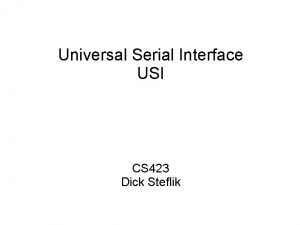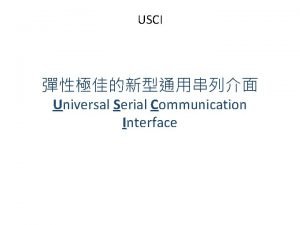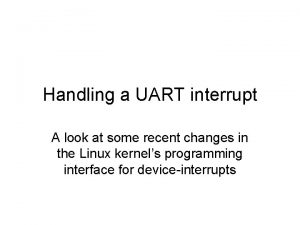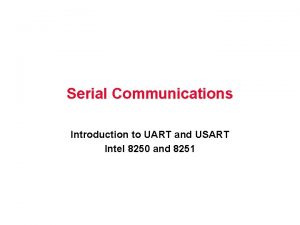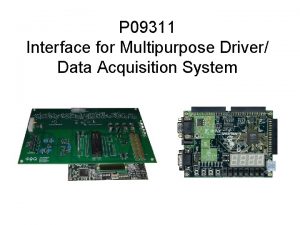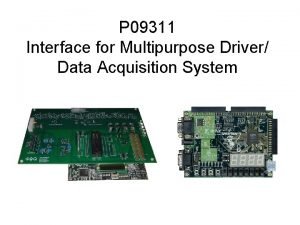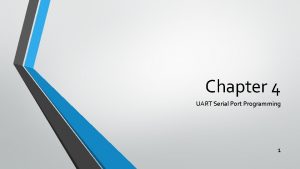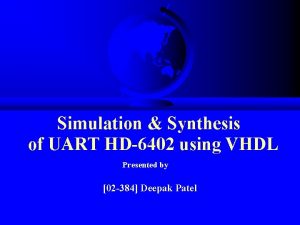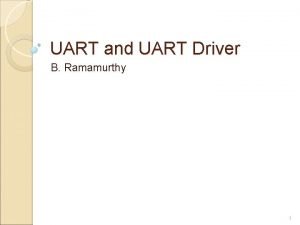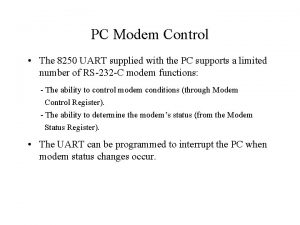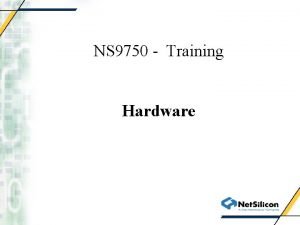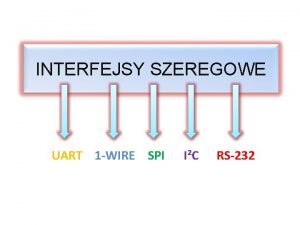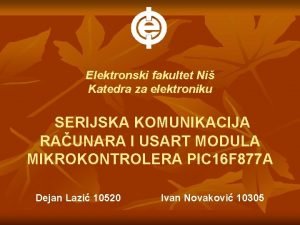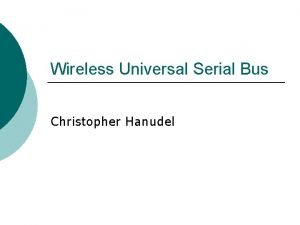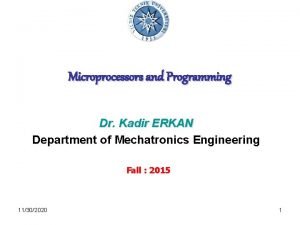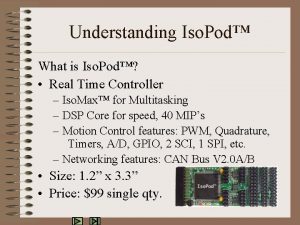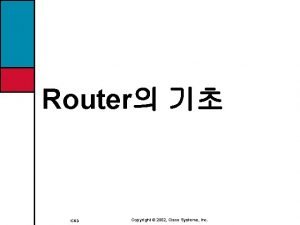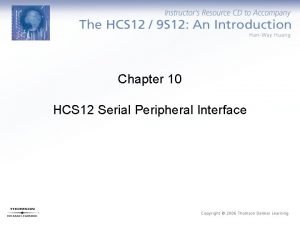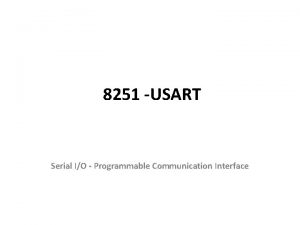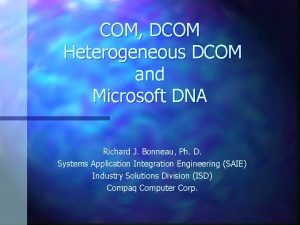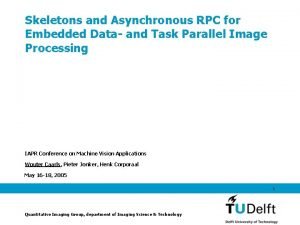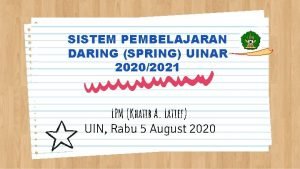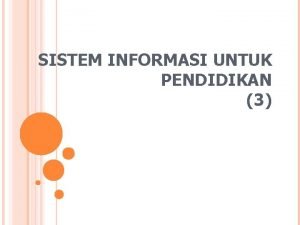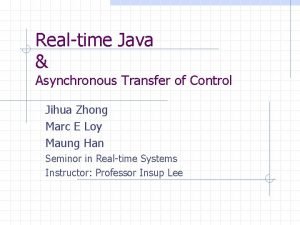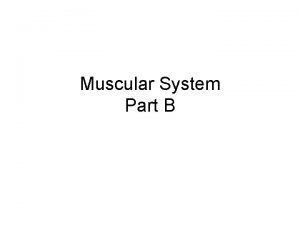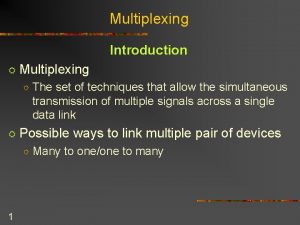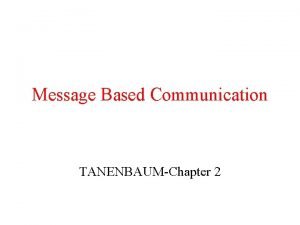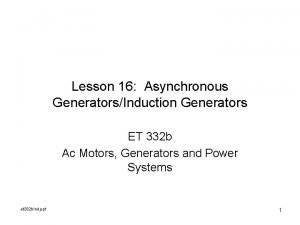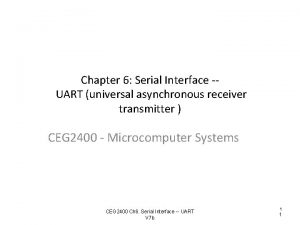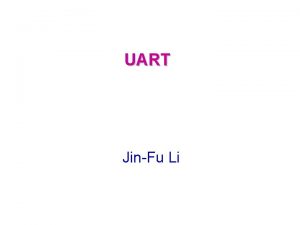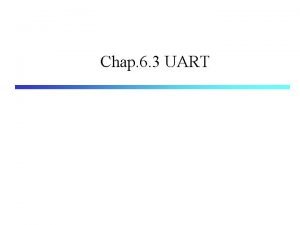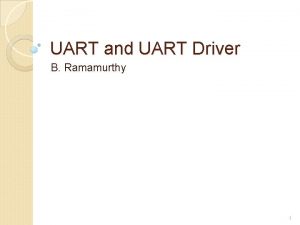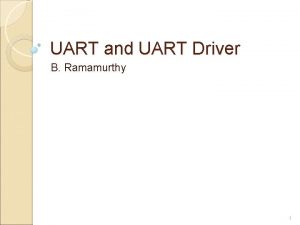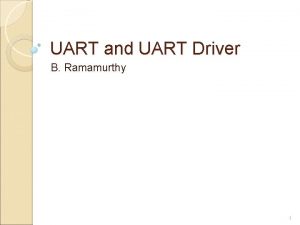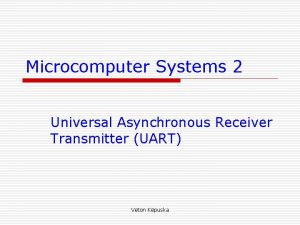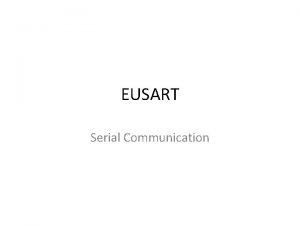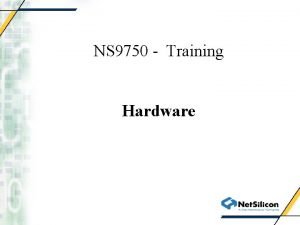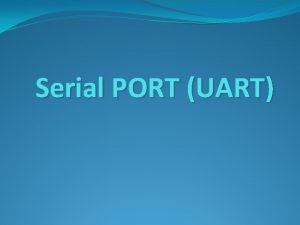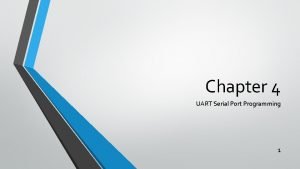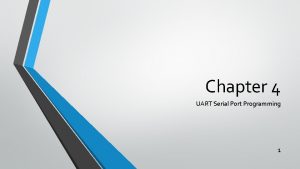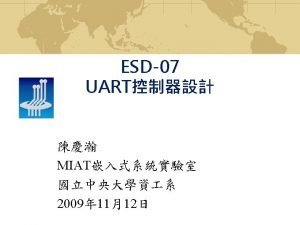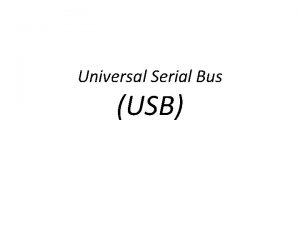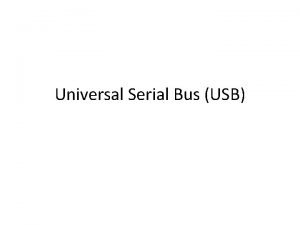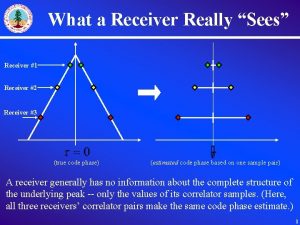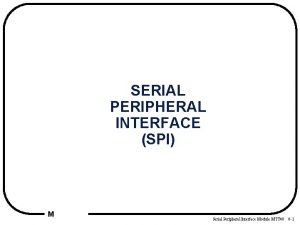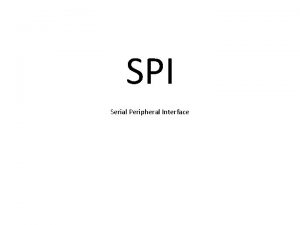Chapter 6 Serial Interface UART universal asynchronous receiver






























![Step 2: U 0 FCR--FIFO control set reg=0 x 07 [U 0 FCR]=0 x Step 2: U 0 FCR--FIFO control set reg=0 x 07 [U 0 FCR]=0 x](https://slidetodoc.com/presentation_image_h2/0946a0aaf763668240174645eee85376/image-31.jpg)












- Slides: 43

Chapter 6: Serial Interface -UART (universal asynchronous receiver transmitter ) CEG 2400 - Microcomputer Systems CEG 2400 Ch 6. Serial Interface -- UART V 7 b 1 1

Overview 1. Introduction to the universal asynchronous receiver transmitter : UART. 2. UART Hardware Interface 3. UART Software Interface 4. Initialize the UART Hardware 5. Sending data using handshaking CEG 2400 Ch 6. Serial Interface -- UART V 7 b 2 2

1) Introduction: Serial interface (universal asynchronous receiver transmitter : UART) • RS 232 standard and application, e. g. RS 232 standard 3 wires +10 V=‘ 0’=SPACE -10 V=‘ 1’=MARK Pin 3 Pin 2 RS 232 port Pin 2 Pin 3 pin 5 (UART) pin 5 CEG 2400 Ch 6. Serial Interface -- UART V 7 b http: //docs. sgi. com/library/dynaweb_docs/hdwr/SGI_End. User/books/IXbric. Add/sgi_html/figures/IXbrick. serialport. pinouts. gif RS 232 port (UART) 3 3

U Universal A Asynchronous R Receiver T Transmitter UART for data communication • Serial data transmission means sending data bits one by one using one wire. • Asynchronous transmission means a data (including one start bit , 8 -bit data, and stop bits) can be sent at any time. CEG 2400 Ch 6. Serial Interface -- UART V 7 b 4 4

Universal asynchronous receiver transmitter : UART • RS 232 is a serial communication standard • Since it is asynchronous, no external clock is needed, only 3 wires are required for the simplest RS 232 connection {GND, tx(transmit), rx(receive)} Bit 0 to 7 (least sig. bit first ) Start 0 1 2 3 4 5 6 7 stop +10 V=Logic 0=space -10 V= Logic 1=mark time Exercise: Sketch Bit Patterns for character A and B http: //www. maxim-ic. com/app-notes/index. mvp/id/83/ CEG 2400 Ch 6. Serial Interface -- UART V 7 b 5 5

ASCII table http: //www. cs. utk. edu/~pham/ascii_table. jpg CEG 2400 Ch 6. Serial Interface -- UART V 7 b 6 6

EXAMPLES • Sending ASCII • ‘ 5’=0 x 35=0011 0101 b The whole ASCII serial character has 10 bits (1 start+8 data + 1 stop bit) Start bit=0 T=bit period =1/baud rate Oscilloscope Probe Stop bit=1 10101100(stop bit=1) Least Sign. Bit first What is this code ? CEG 2400 Ch 6. Serial Interface -- UART V 7 b 7 7

If the baud rate is 57600 bits per second Define ‘bit period’ : the amount of time to transmit a logic 1 or 0. (bit period= 1/57600 seconds) • Each bit lasts for (1/Baud rate) seconds bit period = 1/baud rate =(1 / 57600) seconds=17. 4 us Exercise: What is the “bit period” in seconds if the baud rate is 2400? CEG 2400 Ch 6. Serial Interface -- UART V 7 b 8 8

Hello world example/references • Manual: UM_LPC 21 XX_LPC 22 XX_2. pdf – https: //github. com/sgh/aos/blob/master/doc/processors/UM_ LPC 21 XX_LPC 22 XX_2. pdf • Application Note: AN 10369_1. pdf – http: //uglyduck. ath. cx/PDF/Philips/LPC 2000/AN 10369_1. pdf • from course/tutorial web page – astartup. s – ahello. s (appendix 1) CEG 2400 Ch 6. Serial Interface -- UART V 7 b 9 9

2) UART Hardware Interface CEG 2400 Ch 6. Serial Interface -- UART V 7 b 10 10

UART Hardware Interface • ARM 7 output signals are 0 ->3. 3 V. • A MAX 232 chip is needed to translate the 0 ->3. 3 V levels to the +/-10 V RS 232 levels (with power VCC=5 V, the electronic circuit can do that!!) CEG 2400 Ch 6. Serial Interface -- UART V 7 b 11 11

Ref: page 9 of ARM 7 -LPC 213 x-user manual (Hardware Guide, UM 10120) http: //www. nxp. com/documents/user_manual/UM 10120. pdf ARM system support for UART: Memory Map • Software interface involves appropriately programming registers in the memory map to manipulate the hardware • i. e. from 0 x. E 000 C 000 to 0 x. E 000 C 030 for UART ports CEG 2400 Ch 6. Serial Interface -- UART V 7 b • 12 12

Like office addresses for mail delivery • UART Office addresses from floor – 0 x. E 000 C 000 to – 0 x. E 000 C 030 Memory address space CEG 2400 Ch 6. Serial Interface -- UART V 7 b 13 13

Reminded that ARM 7 has these registers and memory addresses – Registers (R 0 -R 15). . etc UART Office addresses from floor 0 x. E 000 C 000 to 0 x. E 000 C 030 • 32 -bit memory addresses (0 x 0000 to 0 x. FFFF) 0 x. E 000 C 000 to 0 x. E 000 C 030 CEG 2400 Ch 6. Serial Interface -- UART V 7 b 14

Revision • Name the usages of these memory locations in an ARM (LPC 21 xx) processor • 0000 7 FFFh ? _______ • ROM, code • 4000 0000 4000 FFFFh ? _______ • RAM, data, Stack • E 000 C 000 E 000 C 030 ? _______ • (UART) CEG 2400 Ch 6. Serial Interface -- UART V 7 b 15

UART Register address map : 0 x. E 000 C 000 to 0 x. E 000 C 030 U 0 RBR (read only ) and U 0 THR (write only) share the same address but have no conflict (because one is for “write” another is for “read”). Ref: table 96 of ARM 7 -LPC 213 x-user manual (Hardware Guide, UM 10120) http: //www. nxp. com/documents/user_manual/UM 10120. pdf • DLAB=0 DLAB=1 CEG 2400 Ch 6. Serial Interface -- UART V 7 b 16 16

3) UART A general description of the software Interface ahello. s http: //www. cse. cuhk. edu. hk/%7 Ekhwong/www 2/ceng 2400/ahello. s CEG 2400 Ch 6. Serial Interface -- UART V 7 b 17 17

Part 3: subroutine to initialize uart 0 Part 1: define registers • • File name : ahello. s • • ; UART 0 registers • • • U 0 RBR U 0 THR U 0 IER U 0 IIR U 0 FCR U 0 LSR U 0 SCR U 0 DLL U 0 DLM PINSEL 0 EQU EQU EQU 0 x. E 000 C 000 0 x. E 000 C 004 0 x. E 000 C 008 0 x. E 000 C 014 0 x. E 000 C 01 C 0 x. E 000 C 000 0 x. E 000 C 004 0 x. E 002 C 000 • • ; User Initial Stack & Heap AREA |. text|, CODE, READONLY • • • • • • • EXPORT __main BL loop MOV iuart 0 R 0, #'H' BL MOV BL MOV BL MOV BL B Part 2: main program writec R 0, #'e' writec R 0, #'l' writec R 0, #'o' writec R 0, #'w' writec R 0, #'o' writec R 0, #'r' writec R 0, #'l' writec R 0, #'d' writec R 0, #'n' writec loop iuart 0 MOV LDR STR R 1, #0 x 5 ; PINSEL 0 = 0 x 5 R 0, =PINSEL 0 R 1, [R 0] • • MOV LDR STRB R 1, #0 x 7 R 0, =U 0 FCR R 1, [R 0] ; U 0 FCR = 0 x 7 MOV LDR STRB R 1, #0 x 83 R 0, =U 0 LCR R 1, [R 0] ; U 0 LCR = 0 x 83 • • • MOV LDR STRB R 1, #0 x 0 f R 0, =U 0 DLL R 1, [R 0] ; U 0 DLL = 0 x 0 f • • • MOV LDR STRB R 1, #0 x 00 R 0, =U 0 DLM R 1, [R 0] ; U 0 DLM = 0 x 0 R 1, #0 x 03 R 0, =U 0 LCR R 1, [R 0] R 14 ; U 0 LCR = 0 x 03 • • MOV LDR STRB BX return from subroutine ; Part 4: subroutine to write data to serial port • • writec LDRB TST BEQ LDR STRB BX return from subroutine CEG 2400 Ch 6. Serial Interface • END-- UART V 7 b R 1, =U 0 LSR R 1, [R 1] R 1, #0 x 40 writec R 1, =U 0 THR R 0, [R 1] R 14 ; 18 18

Part 1 of ahello. s ; send hello to the serial line • Define the address locations of the UART 0(Universal asynchronous receiver transmitter) registers • ; UART 0 registers • • • U 0 RBR EQU U 0 THR EQU U 0 IER EQU U 0 IIR EQU U 0 FCR EQU U 0 LSR EQU U 0 SCR EQU U 0 DLL EQU U 0 DLM EQU PINSEL 0 EQU 0 x. E 000 C 000 0 x. E 000 C 004 0 x. E 000 C 008 0 x. E 000 C 014 0 x. E 000 C 01 C 0 x. E 000 C 000 0 x. E 000 C 004 0 x. E 002 C 000 RS 232 standard 3 wires +10 V=‘ 0’=SPACE -10 V=‘ 1’=MARK RS 232 port (UART) Pin 3 Pin 2 pin 5 CEG 2400 Ch 6. Serial Interface -- UART V 7 b Pin 2 Pin 3 pin 5 RS 232 port (UART) 19 19

Define Uart Registers in assembly (in lpc 21 xx. h (ARM 7) generated by uvision 3 of the Keil assembler tool) ; UART 0 registers U 0 RBR EQU U 0 THR EQU U 0 IER EQU U 0 IIR EQU U 0 FCR EQU U 0 LSR EQU U 0 SCR EQU U 0 DLL EQU U 0 DLM EQU PINSEL 0 EQU 0 x. E 000 C 000 0 x. E 000 C 004 0 x. E 000 C 008 0 x. E 000 C 014 0 x. E 000 C 01 C 0 x. E 000 C 000 0 x. E 000 C 004 0 x. E 002 C 000 EQU Pseudo instruction Define a constant X EQU 2 This is an assembler directive that is used to give a value to a label name. In this example it assigns X the value 2. Thus when X is used elsewhere in the code, the value 2 will be substituted (similar to using a #define to set up a constant in the C language). CEG 2400 Ch 6. Serial Interface -- UART V 7 b 20 20

• ; User Initial Stack & Heap • AREA |. text|, CODE, READONLY • EXPORT __main • __main BL iuart 0 • loop MOV R 0, #'H' • BL writec In this program, it writes “hello • MOV R 0, #'e' world” to the serial line. • BL writec • MOV R 0, #'l' • BL writec • MOV R 0, #'o' • BL writec • MOV R 0, #'w' • BL writec • MOV R 0, #'o' • BL writec • MOV R 0, #'r' • BL writec • MOV R 0, #'l' • BL writec • MOV R 0, #'d' • BL writec • MOV R 0, #'n' • BL writec CEG 2400 Ch 6. Serial Interface -- UART • B loop Part 2 of ahello. s ; send hello to the serial line • V 7 b Print hello world 21

Part 3 of ahello. s, (subroutine iuart 0: initialize uart 0 registers) • • iuart 0 MOV LDR STR • • MOV LDR STRB R 1, #0 x 7 R 0, =U 0 FCR R 1, [R 0] ; U 0 FCR = 0 x 7 MOV LDR STRB R 1, #0 x 83 R 0, =U 0 LCR R 1, [R 0] ; U 0 LCR = 0 x 83 • • MOV LDR STRB R 1, #0 x 0 f R 0, =U 0 DLL R 1, [R 0] ; U 0 DLL = 0 x 0 f MOV LDR STRB R 1, #0 x 00 ; U 0 DLM = 0 x 0 R 0, =U 0 DLM R 1, [R 0] • • • R 1, #0 x 5 ; PINSEL 0 = 0 x 5 R 0, =PINSEL 0 R 1, [R 0] MOV R 1, #0 x 03 ; U 0 LCR = 0 x 03 LDR R 0, =U 0 LCR STRB R 1, [R 0] BX R 14 ; return from subroutine CEG 2400 Ch 6. Serial Interface -- UART V 7 b 22 22

Part 4 of ahello. s (subroutine writec: write one character to the serial line) • writec • LDRB • TST • BEQ • LDR • STRB • BX • • LDR R 1, =U 0 LSR R 1, [R 1] R 1, #0 x 40 writec R 1, =U 0 THR R 0, [R 1] R 14 ; return from subroutine END CEG 2400 Ch 6. Serial Interface -- UART V 7 b 23 23

4) Detailed description of subroutines “iuart 0” in ahello. s Initialize the UART Hardware Setup data into UART registers 0 x. E 000 C 000 to 0 x. E 000 C 030 CEG 2400 Ch 6. Serial Interface -- UART V 7 b 24 24

Part 3 of ahello. s Initialize uart 0 (iuart 0) in ahello. s (Appendix 1) step 4 Step 1: iuart 0 setup pins MOV R 1, #0 x 5 LDR R 0, =PINSEL 0 STR R 1, [R 0] MOV R 1, #0 x 7 LDR R 0, =U 0 FCR STRB R 1, [R 0] MOV R 1, #0 x 83 LDR R 0, =U 0 LCR STRB R 1, [R 0] step 2 MOV R 1, #0 x 0 f LDR R 0, =U 0 DLL STRB R 1, [R 0] MOV R 1, #0 x 00; U 0 DLM = 0 x 0 LDR R 0, =U 0 DLM STRB R 1, [R 0] step 3 CEG 2400 Ch 6. Serial Interface -- UART V 7 b 25 25

Subroutine iuart 0: Software to initialize the UART in the LPC 21 xx (ARM 7) chipset • inside iuart 0 – Step 1: setup pins • configure pin function select reg. i. e. pin 19=TXD – Step 2 • configure FIFO control reg. – Step 3 • configure line control reg. (start, stop bits) – Step 4 • Configure baud rate CEG 2400 Ch 6. Serial Interface -- UART V 7 b 26 26

Step 1 of iuart 0: pin configuration=0 x 05 • Configure the pin for serial interfaces • Arm 7 pins are multi functions, depending on initialization. • E. g. configure pin-symbol “p 0. 0” (pin 19 or p 0. 0) to be the serial transmission pin “TXD” • You must set Bit 1: 0 of address 0 x. E 002 C 000=“ 01”. CEG 2400 Ch 6. Serial Interface -- UART V 7 b 27 27

Exercise 6. 1 : which pin (what Px, y) is RXD? PINSEL 0 --pin function select reg. [0 XE 002 C 000]=0 x 05 bit 0, bit 2 are 1 Somewhere inside there Setup Pin 19 or P 0. 0 to have the function of TXD CEG 2400 Ch 6. Serial Interface -- UART V 7 b 28 28

Exercise 6. 1 : which pin (what Px, y) is RXD? Answer: P 0. 1 or pin 21 PINSEL 0 --pin function select reg. [0 XE 002 C 000]=0 x 05 bit 0, bit 2 are 1 Setup Pin 19 or P 0. 0 to have the function of TXD Answer: Setup Pin 21 or P 0. 1 to have the function of RXD CEG 2400 Ch 6. Serial Interface -- UART V 7 b 29 29

Step 2 of iuart 0: —setup FIFO control iuart 0 MOV R 1, #0 x 5 LDR R 0, =PINSEL 0 STR R 1, [R 0] MOV R 1, #0 x 7 LDR R 0, =U 0 FCR STRB R 1, [R 0] MOV R 1, #0 x 83 LDR R 0, =U 0 LCR STRB R 1, [R 0] Step 1: setup pins Step 2: setup First IN First Out ( FIFO) control MOV R 1, #0 x 0 f LDR R 0, =U 0 DLL STRB R 1, [R 0] Step 4 Set Baud= 57600 MOV R 1, #0 x 00; U 0 DLM = 0 x 0 LDR R 0, =U 0 DLM STRB R 1, [R 0] step 3 What do all of these values do? CEG 2400 Ch 6. Serial Interface -- UART V 7 b 30 30
![Step 2 U 0 FCRFIFO control set reg0 x 07 U 0 FCR0 x Step 2: U 0 FCR--FIFO control set reg=0 x 07 [U 0 FCR]=0 x](https://slidetodoc.com/presentation_image_h2/0946a0aaf763668240174645eee85376/image-31.jpg)
Step 2: U 0 FCR--FIFO control set reg=0 x 07 [U 0 FCR]=0 x 07 Set all bit 0, 1, 2=“ 111” for FIFO control CEG 2400 Ch 6. Serial Interface -- UART V 7 b 31 31

Step 3 of iuart 0: Exercise 6. 2, Circle which bits are set, discuss their functions. U 0 LCR—line control set reg=0 x 83 [U 0 LCR]=0 x 83 CEG 2400 Ch 6. Serial Interface -- UART V 7 b 32 32

Exercise 6. 2 a, which bits are set, and their functions. Answer: 8 -bit character length, 1 stop bit, no parity, enable division latch Step 3: U 0 LCR—line control set reg=0 x 83, set reg [U 0 LCR]= =0 x 83=1000 0011 B [U 0 LCR]= 0 x 83= 1000 0011 B Exercise 2 b: Repeat exercise 2 a but 7 bit data, 1 stop bit , no parity CEG 2400 Ch 6. Serial Interface -- UART Answer: U 0 LCR=10000010 b=0 x 82 V 7 b 33 33

Step 2 of iuart 0: U 0 DLL—set baud rate=0 x 0 F [U 0 DLL]=0 x 0 F, set Baudrate=576000 • U 0 DLL = Fpclk / (16 * Baudrate) • If we want 57600 baud (Fpclk=13. 824 MHz) then U 0 DLL=15=0 x 0 f (U 0 DLM(for msc)=00; U 0 DLL(for lsb)=15) • Check datasheet of how it should be set. • Exercise 4 a: How to set the baud rate to be 9600? – Answer 4: U 0 DLL 9600 = Fpclk / (16 * Baudrate) – =13. 824 MHz / (16 * 9600)=90 – Also U 0 DLM 9600 =00 • Exercise 4 b: How to set Baud rate = 2400? • • Useful tool: http: //www. binaryhexconverter. com/decimal-to-hex-converter 13824000/(16(16 M+L))=2400 13824000/(16*2400)=360=16 M+L CEG 2400 Ch 6. Serial Interface -- UART M=? _____, L=? _____ V 7 b 34 34

5) Detailed description of subroutines “writec” : Sending data using handshaking CEG 2400 Ch 6. Serial Interface -- UART V 7 b 35 35

Subroutine Writec: Basic concept of sending a character using the serial port • The sending procedure is slower (e. g. only 57600 bits per second) than your program, so it needs to ask permission to send Sending rate (Baud rate) • Writec() is slower than your program can gen. data True even for usb 2 receiver Send-buffer Is transmitter Buffer empty ? no yes Send data CEG 2400 Ch 6. Serial Interface -- UART V 7 b 36

CEG 2400 Ch 6. Serial Interface -- UART V 7 b Read buffer status U 0 LSR(0 x. E 000 C 014) 37

U 0 LSR—line status at U 0 LSR(0 x. E 000 C 014) (if bit 6=TEMT (transmitter empty)=1 you can send next data Bit 7 Bit 0 CEG 2400 Ch 6. Serial Interface -- UART V 7 b 38

Recall: TST and BEQ • TST – Same as AND (logical AND) except result of operation is not stored. – Only the condition code bits (cc) {N, Z, C, V} in CPSR are changed. • updates the N and Z flags according to the result • Does not affect the C or V flags. • BEQ – Branch if result equal to zero (branch if Z=1) CEG 2400 Ch 6. Serial Interface -- UART V 7 b 39 39

Write character in R 0 subroutine when TEMT=1 TEMT=0 meaning transmitter is not empty, not ready to send TEMT=1 meaning transmitter is empty, ready to send 1)Writec ; subroutine to send data in R 0 to serial out 2) LDR R 1, =U 0 LSR; (line status reg) 3) LDRB R 1, [R 1]; get line status 4) TST R 1, #0 x 40 ; TEMT(bit 6 of ; U 0 LSR=1=buffer_empty)=0 Z=1 5) BEQ writec ; if Z=1(buffer_not_empty), ; loop back writec to wait 6) LDR R 1, =U 0 THR; U 0 THR=transmit reg 7) STRB R 0, [R 1]; send data out 8) BXR 14 ; return from subroutine TST : same as “AND”, but result is not saved , affect Z bit in cpsr CEG 2400 Ch 6. Serial Interface -- UART V 7 b 40

Flow diagram of Writec of ahello. s TEMT=0 meaning transmitter is not empty, not ready to send TEMT=1 meaning transmitter is empty, ready to send • Reason: The sending speed (Bit per second) is slower than your program, need to ask permission to send Writec( ); write data in R 0 4)TST R 1, #0 x 40 ; TEMT=0 (buffer_not _empty: transmitter not ready) Z=1 ; TEMT=1 (buffer_empty: transmitter is ready) Z=0 Brach if Z=1 5) BEQ writec If Z=0 If Z=1 Is the transmitter buffer is not empty, loop back. Because TEMT=0 Z=1, BEQ writec ; if Z=1, loop back to wait Otherwise send data 6) LDR R 1, =U 0 THR 7) STRB R 0, [R 1]; send data. CEG 2400 out Ch 6. Serial Interface -- UART V 7 b 41

Summary • Studied serial interface in ARM • Studied handshaking in interfacing CEG 2400 Ch 6. Serial Interface -- UART V 7 b 42

End CEG 2400 Ch 6. Serial Interface -- UART V 7 b 43
 Universal interface
Universal interface Universal serial communication interface
Universal serial communication interface Uart interrupts
Uart interrupts Hdlc uart
Hdlc uart 8251 uart
8251 uart Uart rx
Uart rx Uart rx
Uart rx Samd21 uart example
Samd21 uart example 6402 uart
6402 uart Sci serial communication interface
Sci serial communication interface Logo uart
Logo uart Dte merupakan kepanjangan dari
Dte merupakan kepanjangan dari Uart driver
Uart driver 8250 uart
8250 uart Uart hdlc
Uart hdlc 3-wire serial interface
3-wire serial interface Programiranje mikrokontrolera
Programiranje mikrokontrolera Parallel in serial out shift register
Parallel in serial out shift register Drama serial drama serial
Drama serial drama serial Wireless universal serial bus
Wireless universal serial bus Usb nrzi
Usb nrzi Kadir erkan
Kadir erkan Serial communication and parallel communication
Serial communication and parallel communication Serial communication interface
Serial communication interface Serial interface
Serial interface Serial peripheral interface standard
Serial peripheral interface standard Serial communication interface 8251
Serial communication interface 8251 Precise strike pathfinder
Precise strike pathfinder Universal interface
Universal interface Universal interface
Universal interface Universal interface
Universal interface Interface in java
Interface in java Abowd and beale framework example
Abowd and beale framework example Office interface vs industrial interface
Office interface vs industrial interface Interface------------ an interface *
Interface------------ an interface * Importance of sound in film
Importance of sound in film Asynchronous rpc
Asynchronous rpc Pembelajaran synchronous dan asynchronous
Pembelajaran synchronous dan asynchronous Pembelajaran synchronous dan asynchronous
Pembelajaran synchronous dan asynchronous Asynchronous transfer of control
Asynchronous transfer of control Eccentric movement
Eccentric movement Synchronous and asynchronous tdm
Synchronous and asynchronous tdm Transient communication examples
Transient communication examples Asynchronous generator python
Asynchronous generator python
